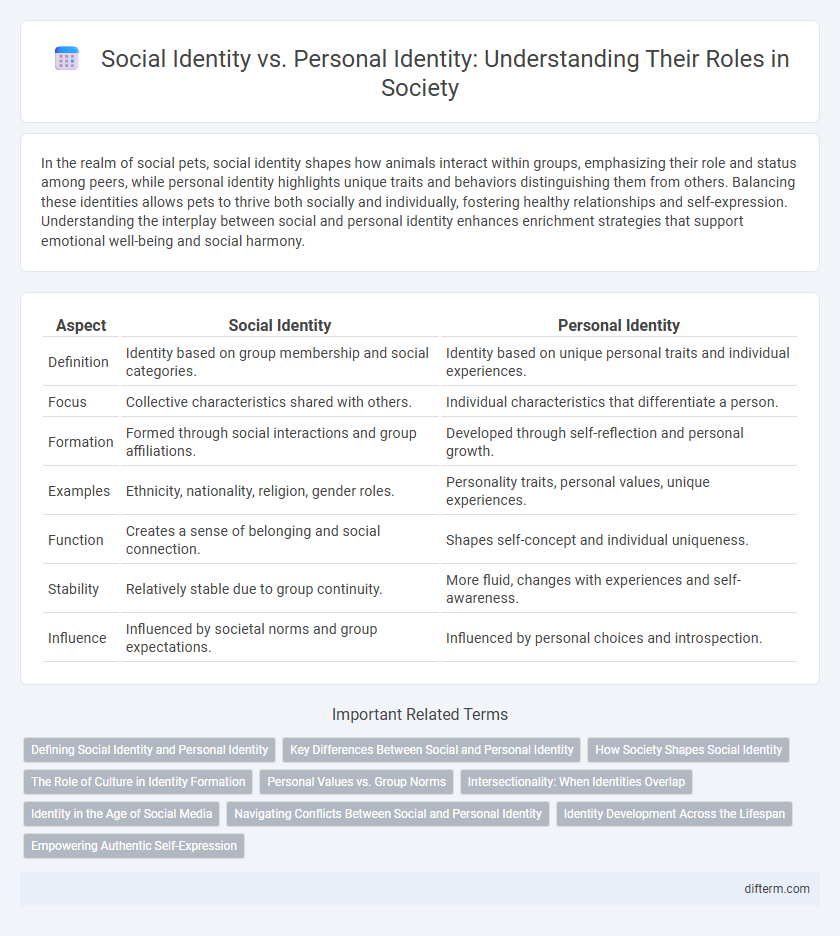In the realm of social pets, social identity shapes how animals interact within groups, emphasizing their role and status among peers, while personal identity highlights unique traits and behaviors distinguishing them from others. Balancing these identities allows pets to thrive both socially and individually, fostering healthy relationships and self-expression. Understanding the interplay between social and personal identity enhances enrichment strategies that support emotional well-being and social harmony.
Table of Comparison
| Aspect | Social Identity | Personal Identity |
|---|---|---|
| Definition | Identity based on group membership and social categories. | Identity based on unique personal traits and individual experiences. |
| Focus | Collective characteristics shared with others. | Individual characteristics that differentiate a person. |
| Formation | Formed through social interactions and group affiliations. | Developed through self-reflection and personal growth. |
| Examples | Ethnicity, nationality, religion, gender roles. | Personality traits, personal values, unique experiences. |
| Function | Creates a sense of belonging and social connection. | Shapes self-concept and individual uniqueness. |
| Stability | Relatively stable due to group continuity. | More fluid, changes with experiences and self-awareness. |
| Influence | Influenced by societal norms and group expectations. | Influenced by personal choices and introspection. |
Defining Social Identity and Personal Identity
Social identity refers to an individual's sense of belonging to specific social groups based on characteristics such as nationality, ethnicity, religion, or occupation, shaping how they relate to others in society. Personal identity encompasses the unique traits, values, experiences, and beliefs that distinguish an individual from others, contributing to self-concept and individuality. Understanding both social and personal identity is crucial for analyzing how people perceive themselves and interact within social contexts.
Key Differences Between Social and Personal Identity
Social identity is defined by group memberships, such as nationality, ethnicity, or religion, shaping how individuals perceive themselves within a societal context. Personal identity centers on unique individual traits, values, and experiences that distinguish a person from others regardless of group affiliations. Key differences include social identity's collective nature versus personal identity's emphasis on individuality and internal self-concept.
How Society Shapes Social Identity
Society shapes social identity through shared cultural norms, values, and group memberships that influence individual behaviors and self-perceptions. Social institutions such as family, education, and media play key roles in reinforcing collective identities and social roles. Interactions within diverse communities further mold social identity, highlighting the dynamic relationship between societal structures and individual self-concept.
The Role of Culture in Identity Formation
Culture significantly shapes social identity by providing shared values, norms, and traditions that connect individuals to larger groups, fostering a sense of belonging and collective self-understanding. Personal identity develops through internalizing cultural meanings, influencing how individuals perceive themselves within their social context and express uniqueness. The dynamic interaction between cultural frameworks and personal experiences creates a complex identity formation process essential for social cohesion and individual differentiation.
Personal Values vs. Group Norms
Personal values shape individual behavior and decision-making, often reflecting deeply held beliefs and ethical standards. Group norms influence social identity by establishing expected behaviors that enhance group cohesion and acceptance. Conflicts between personal values and group norms can lead to internal tension and drive the evolution of both personal and social identities.
Intersectionality: When Identities Overlap
Intersectionality reveals how overlapping social identities, such as race, gender, and class, interact to shape unique experiences of privilege and discrimination. Social identity reflects group affiliations that influence societal perceptions, while personal identity encompasses individual traits and self-perception. Understanding the interplay between these identities is crucial for addressing complex social inequalities and fostering inclusive environments.
Identity in the Age of Social Media
Social identity on platforms like Facebook and Instagram is often curated, reflecting group affiliations and cultural symbols that shape online personas. Personal identity, while more intimate and self-defined, becomes increasingly intertwined with social feedback and digital interactions, blurring boundaries between public image and private self. The pervasive influence of social media algorithms amplifies identity performance, steering individuals towards conforming narratives that impact both self-perception and societal roles.
Navigating Conflicts Between Social and Personal Identity
Conflicts between social and personal identity arise when group expectations clash with individual beliefs, causing internal tension and stress. Navigating these conflicts requires strategies such as boundary-setting, open communication, and self-reflection to maintain authenticity while respecting social roles. Effective resolution enhances psychological well-being and fosters stronger interpersonal relationships by balancing collective belonging and individual expression.
Identity Development Across the Lifespan
Social identity and personal identity interact dynamically throughout life, influencing self-concept and interpersonal relationships as individuals navigate various social roles and cultural contexts. Identity development across the lifespan involves continuous negotiation between belonging to social groups and maintaining unique personal characteristics, shaped by experiences in family, community, and societal institutions. Research highlights that adolescence and early adulthood are critical periods for identity exploration and consolidation, while later stages involve integrating past identities with evolving self-perceptions.
Empowering Authentic Self-Expression
Social identity shapes how individuals connect with groups and communities, creating a sense of belonging through shared values and cultural backgrounds. Personal identity emphasizes unique traits, beliefs, and experiences that define an individual's authentic self beyond external labels. Empowering authentic self-expression involves balancing societal roles with personal truths to foster genuine connections and self-confidence.
social identity vs personal identity Infographic

 difterm.com
difterm.com